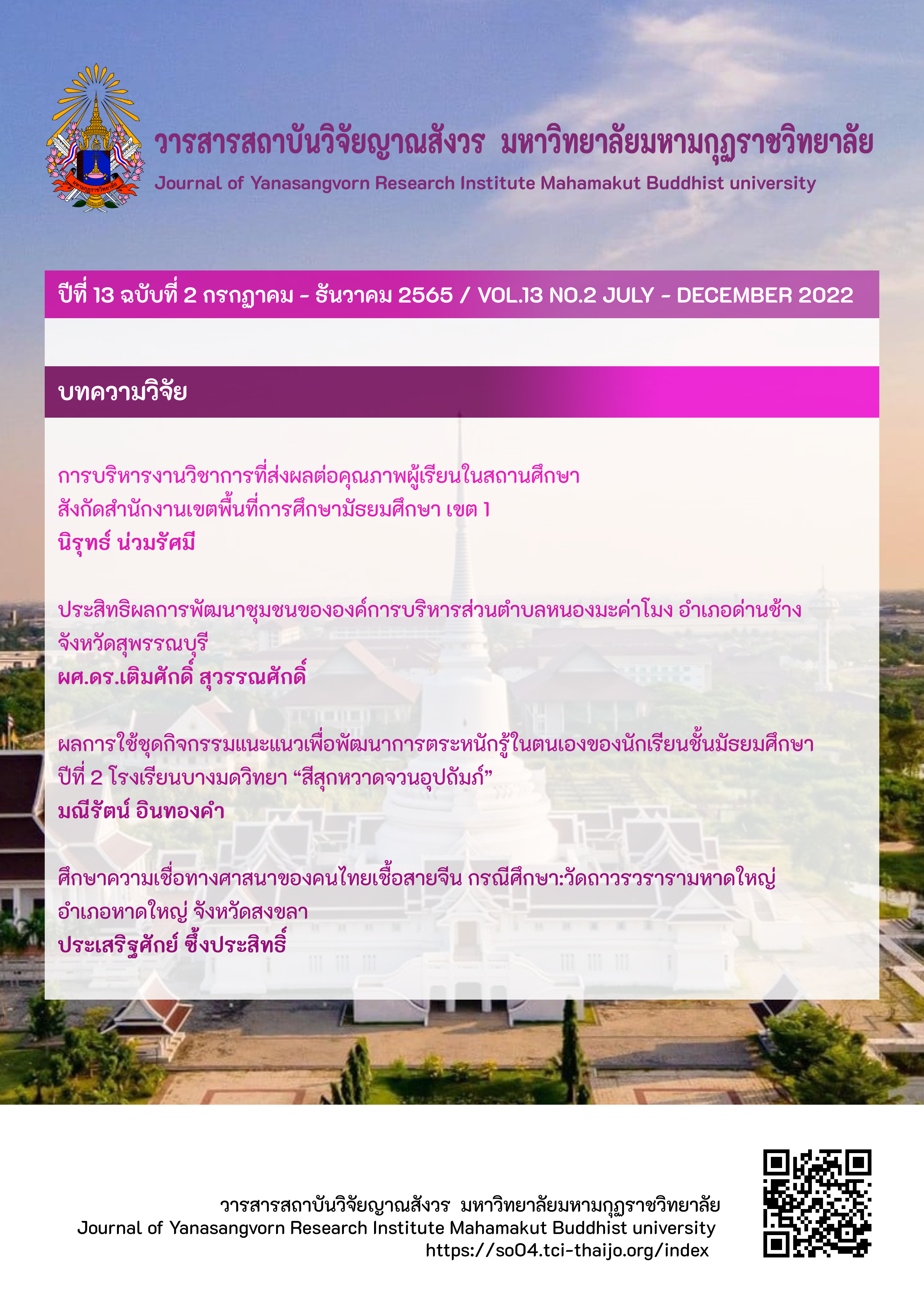ACTIVE LEANING MANAGEMENT AND USING E-PORTFOLIO AS AUTHENTIC ASSESSMENT FOR TEACHER STUDENTS
Main Article Content
Abstract
The research objectives were to 1. study the learning achievement of second-year teacher students on Learning Measurement and Evaluation subject after active learning management and authentic assessment through electronic portfolios with the criteria of 70 percentages, 2. study the authentic assessment result in the teacher students’ electronic portfolios’ quality which were assessed by themselves, their peers and teacher, and 3. study teacher students’ opinions towards active learning management and authentic assessment through electronic portfolios. The purposive random sample consisted of 30 second year teacher students in the academic year 2021. The research instruments consisted of Learning Measurement and Evaluation test, Electronic Portfolio Quality Assessment Form, a questionnaire. The statistics used were percentage, mean, standard deviation.
The research results were as followed 1. the learning achievement of second-year teacher students on Learning Measurement and Evaluation after receiving active learning management and learning authentic assessment through electronic portfolios were overall above the criteria of 70 percentage, mostly grades in excellent level (A), 19 students accounted for 63.33 percentages. 2. the authentic assessment result in the teacher students’ electronic portfolios’ quality through peer assessment overall was at excellent levels and 3. teacher students’ opinions towards active learning management and learning authentic assessment with electronic portfolios was at the high level.
Article Details
References
จันทร์ทิรา เจียรณัย. (2556). การใช้แฟ้มสะสมงานแบบอิเล็กทรอนิกส์ ในรายวิชาแนวคิดพื้นฐานของศาสตร์ทางการพยาบาล (รายงานผลการวิจัย). นครราชสีมา:
มหาวิทยาลัยเทคโนโลยีสุรนารี.
ประวิทย์ โอ้โลม. (2557). การพัฒนาระบบแฟ้มสะสมผลงานอิเล็กทรอนิกส์ร่วมกับระบบการเรียนรู้แบบเพื่อนช่วยเพื่อนวิชาทัศนศิลป์ของนักเรียนชั้นมัธยมศึกษาปีที่ 4
(ปริญญามหาบัณฑิต). มหาวิทยาลัยศิลปากร, นครปฐม.
ผการัตน์ ทองจันทร. (2561). การพัฒนา E-Portfolio สำหรับนักเรียนแสดงผลผ่าน Smart Phone ด้วยการประยุกต์ใช้ QR Code. วารสารวิชาการนวัตกรรมสื่อสาร
สังคม, 6(1), 188.
พรทิพย์ วงศ์ไพบูลย์. (2560). การเรียนรู้เชิงรุกและการมีส่วนร่วมของผู้เรียน (Active Learning).วารสารสถาบันวิจัยญาณสังวร มหาวิทยาลัยมหามกุฏราชวิทยาลัย, 8(2),
-336.
มนตรี ดีโนนโพธิ์. (2564). การพัฒนาทักษะการพูดภาษาจีนเบื้องต้นด้วยกิจกรรมการเรียนรู้แบบเชิงรุก (Active Learning) สำหรับนักศึกษาสาขาวิชาภาษาจีน
มหาวิทยาลัยราชภัฏจันทรเกษม. จันทรเกษมสาร, 27(1), 106-123.
ยุพกา ฟูกุชิม่า. (2564). การทดลองจัดการเรียนการสอนเชิงรุก ในรายวิชาการอ่านภาษาญี่ปุ่นขั้นสูง.วารสารมนุษยศาสตร์วิชาการ, 28(2), 311-367.
วัฒนาพร ระงับทุกข์. (2542). การจัดการเรียนการสอนที่เน้นผู้เรียนเป็นศูนย์กลาง. กรุงเทพฯ: เลิฟแอนด์เลิฟเพรส.
สมศักดิ์ ภู่วิภาดาวรรรธน์. (2544). การยึดผู้เรียนเป็นศูนย์กลางและการประเมินตามสภาพจริง. เชียงใหม่: แสงศิลป์.
อุบลวรรณ ส่งเสริม. (2564). การจัดการเรียนรู้เชิงรุกเพื่อพัฒนาสมรรถนะ การออกแบบกิจกรรมการเรียนรู้เชิงรุกของนักศึกษาครู. วารสารศิลปากรศึกษาศาสตร์วิจัย, 13(2),
-183.
Alfredo Berbegal Vázquez, Abel Merino Orozco, Ana Arraiz Pérez, and Fernando Sabirón Sierra. (2021). The E-Portfolio in Higher Education:
The Case of a Line of Teaching Innovation and Complex Change Management. University of Deusto. p-ISSN: 2340-8170 e-ISSN: 2386-
, 9(1), 29-64.
C.C. Bonwell, J.A. Eison. (1991). Active Learning: Creating Excitement in the Classroom.ERIC Digest. Washington D.C.: ERIC Clearinghouse on
Higher Education.


